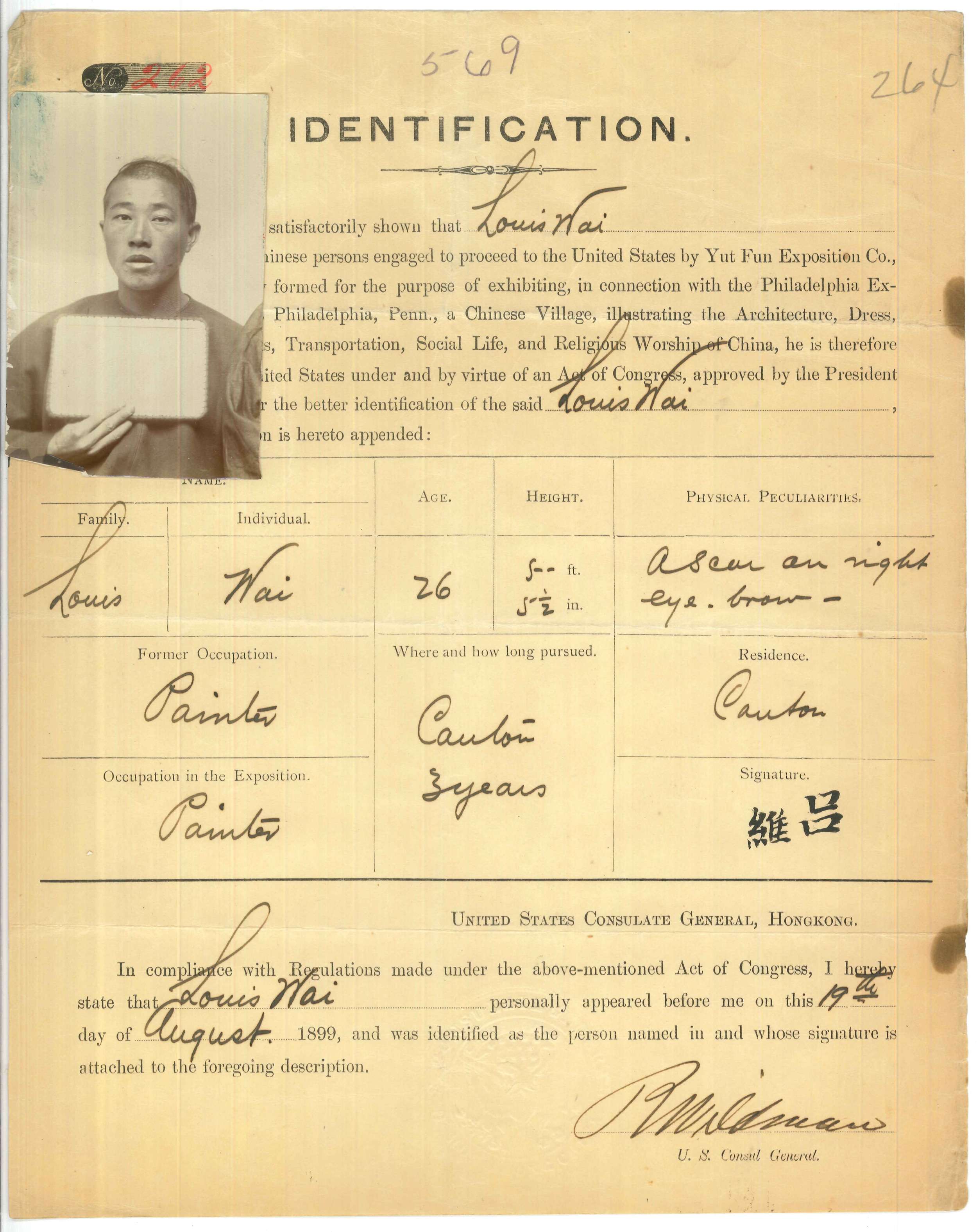The Chinese Village Exhibit at the 1899 Export Exposition
Making Connections
All documents and text associated with this activity are printed below, followed by a worksheet for student responses.Introduction
The documents below are identification papers for Lee Tso, Louis Wai, and Ah Chue – people who were "on exhibit" at the 1899 Export Exposition in Philadelphia as part of a replica "Chinese Village." Because of the Chinese Exclusion Act, they had to get special permission to enter the United States.One challenge is that we know very little about the lives of the people who were part of this exhibit. Here we will explore what can be revealed just by the process of asking questions.
- Examine each document. Click "View Document Details" to look more closely.
- Create a list of as many questions as you can. Record them exactly as stated in the response box following the documents. Number the questions as you go. Do not stop to judge or try to answer the questions, and make sure to change any statements into questions.
- Work together to identify each question as an open-ended or closed-ended question. Put an O or a C next to each.
- Pick your top 3-4 questions to share out loud with the rest of the class.
Name:
Class:
Class:
Worksheet
The Chinese Village Exhibit at the 1899 Export Exposition
Making Connections
Examine the documents and text included in this activity. Fill in any blanks in the sequence with your thoughts and write your conclusion response in the space provided.Identification Paper of Lee Tso
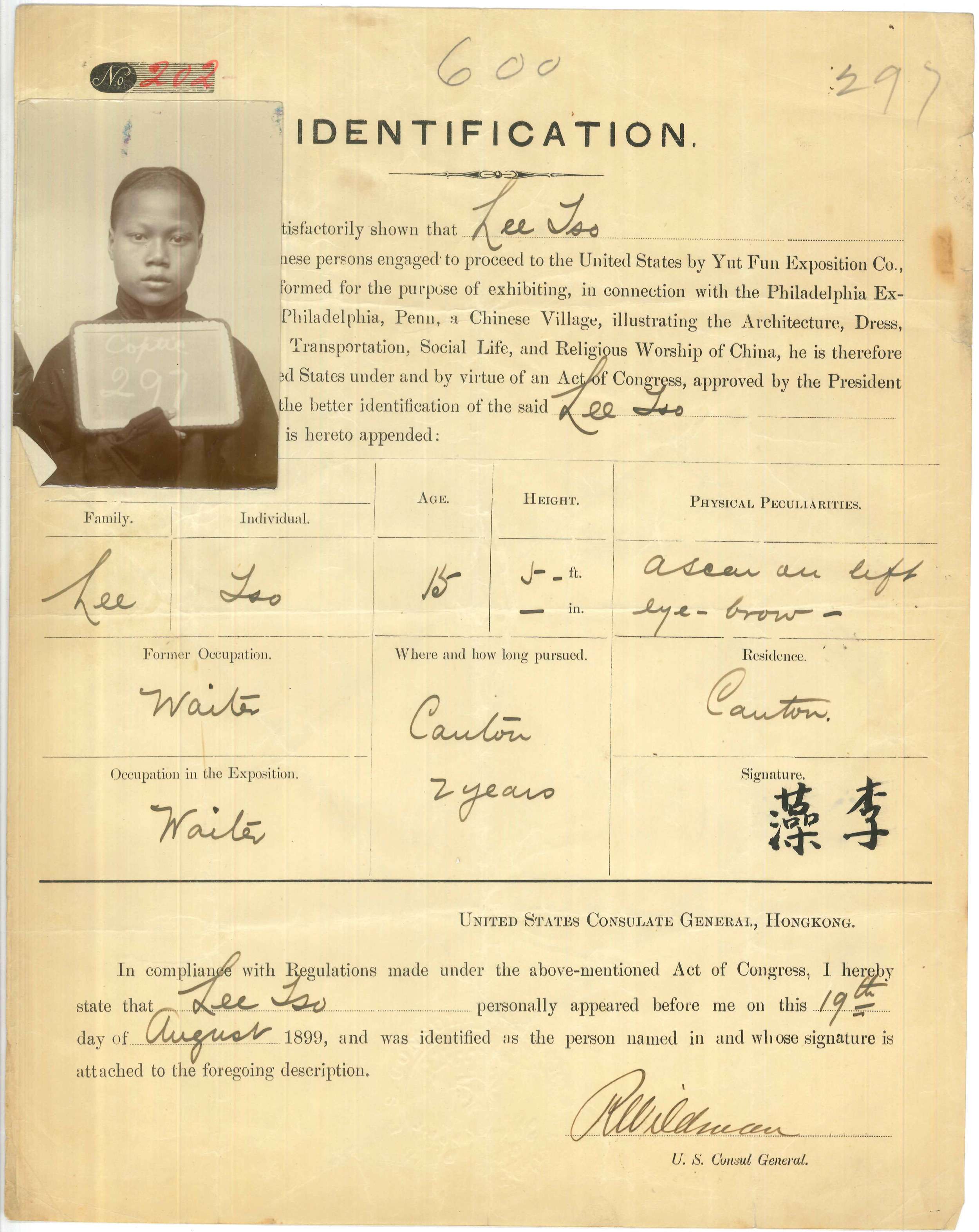
Identification Paper of Ah Chue
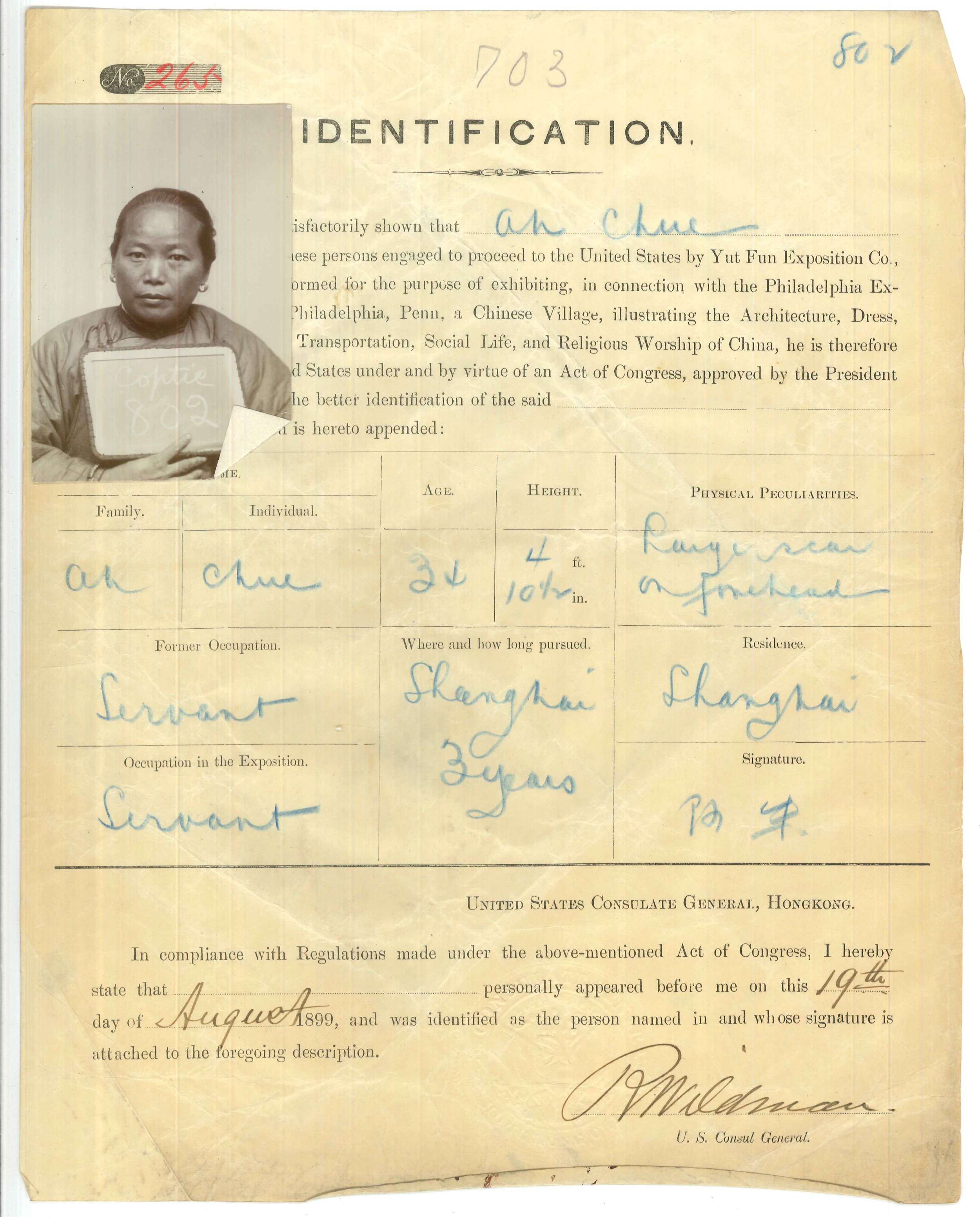
Identification Paper of Louis Wai
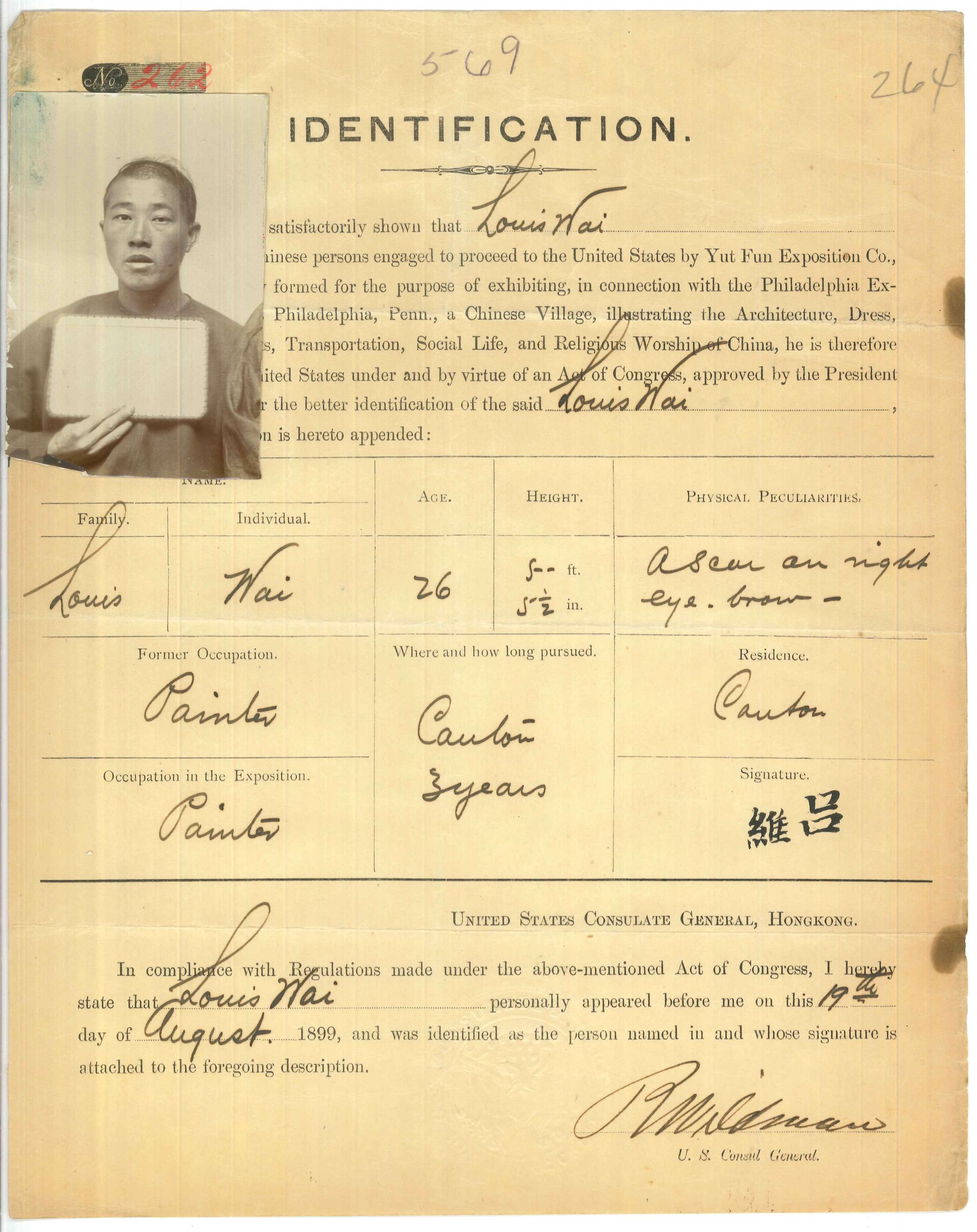
Enter your response
1
Activity Element
Identification Paper of Lee Tso
Page 1

2
Activity Element
Identification Paper of Ah Chue
Page 1

3
Activity Element
Identification Paper of Louis Wai
Page 1

Conclusion
The Chinese Village Exhibit at the 1899 Export Exposition
Making Connections
If you could interview Lee Tso, Louis Wai, or Ah Chue about their experiences, what would you ask them? Write a letter to one of these people including your questions and referring to specific details in the documents.Your Response
Document
Identification Paper of Lee Tso
8/19/1899
Lee Tso was a 15 year old waiter who appeared at the "Chinese Village" exhibition at the National Export Exposition in 1899 in Philadelphia, Pennsylvania. The purpose of the "Chinese Village" was to exhibit and illustrate the architecture, dress, industries, amusements, transportation, social life, and religious worship of China for onlookers at the National Export Exposition.
"Living exhibits" like the "Chinese Village" were often part of exhibitions and fairs in the late 1800s and early 1900s in Europe and the United States. They displayed non-Western people as curiosities, helping to promote the idea of Western progress and superiority that was commonplace at the time.
Lee Tso, along with the other performers, was allowed to enter the United States under an Act of Congress approved by President William McKinley on March 1, 1899. Most other Chinese were excluded from entering the country as a result of the Chinese Exclusion Act of 1882, and its extention in the form of the Geary Act of 1892.
This I.D. paper includes Lee Tso's name, age, height, physical description, occupation, location and length of time engaged in occupation, place of residence, signature, and photograph.
"Living exhibits" like the "Chinese Village" were often part of exhibitions and fairs in the late 1800s and early 1900s in Europe and the United States. They displayed non-Western people as curiosities, helping to promote the idea of Western progress and superiority that was commonplace at the time.
Lee Tso, along with the other performers, was allowed to enter the United States under an Act of Congress approved by President William McKinley on March 1, 1899. Most other Chinese were excluded from entering the country as a result of the Chinese Exclusion Act of 1882, and its extention in the form of the Geary Act of 1892.
This I.D. paper includes Lee Tso's name, age, height, physical description, occupation, location and length of time engaged in occupation, place of residence, signature, and photograph.
This primary source comes from the Records of the Immigration and Naturalization Service.
National Archives Identifier: 183550380
Full Citation: Identification Paper of Lee Tso; 8/19/1899; Identification Papers of Chinese Exhibitors Appearing at the National Export Exposition of 1899, 1899 - 1899; Records of the Immigration and Naturalization Service, ; National Archives at Philadelphia, Philadelphia, PA. [Online Version, https://www.docsteach.org/documents/document/identification-paper-lee-tso, April 25, 2024]Identification Paper of Lee Tso
Page 1
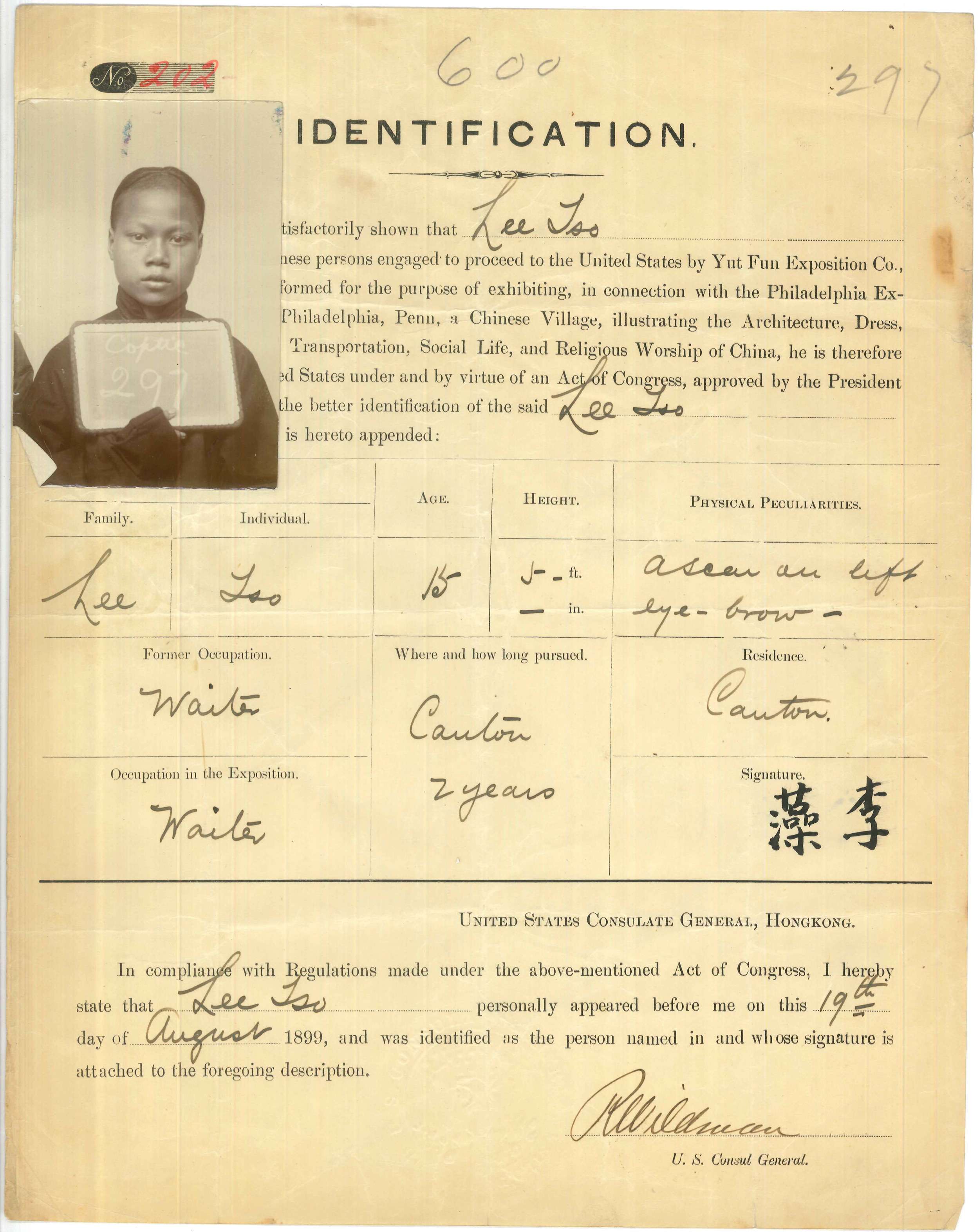
Document
Identification Paper of Ah Chue
8/19/1899
Thirty-four year old Ah Chue, whose occupation was listed as "servant," appeared at the "Chinese Village" exhibition at the National Export Exposition in 1899 in Philadelphia, Pennsylvania. The purpose of the "Chinese Village" was to exhibit and illustrate the architecture, dress, industries, amusements, transportation, social life, and religious worship of China for onlookers at the National Export Exposition.
"Living exhibits" like the "Chinese Village" were often part of exhibitions and fairs in the late 1800s and early 1900s in Europe and the United States. They displayed non-Western people as curiosities, helping to promote the idea of Western progress and superiority that was commonplace at the time.
Along with the other performers, Ah Chue was allowed to enter the United States under an Act of Congress approved by President William McKinley on March 1, 1899. Most other Chinese were excluded from entering the country as a result of the Chinese Exclusion Act of 1882, and its extention in the form of the Geary Act of 1892.
This I.D. paper includes Ah Chue's name, age, height, physical description, occupation, location and length of time engaged in occupation, place of residence, signature, and photograph.
"Living exhibits" like the "Chinese Village" were often part of exhibitions and fairs in the late 1800s and early 1900s in Europe and the United States. They displayed non-Western people as curiosities, helping to promote the idea of Western progress and superiority that was commonplace at the time.
Along with the other performers, Ah Chue was allowed to enter the United States under an Act of Congress approved by President William McKinley on March 1, 1899. Most other Chinese were excluded from entering the country as a result of the Chinese Exclusion Act of 1882, and its extention in the form of the Geary Act of 1892.
This I.D. paper includes Ah Chue's name, age, height, physical description, occupation, location and length of time engaged in occupation, place of residence, signature, and photograph.
This primary source comes from the Records of the Immigration and Naturalization Service.
National Archives Identifier: 183550392
Full Citation: Identification Paper of Ah Chue; 8/19/1899; Identification Paper No. 265; Identification Papers of Chinese Exhibitors Appearing at the National Export Exposition of 1899, 1899 - 1899; Records of the Immigration and Naturalization Service, ; National Archives at Philadelphia, Philadelphia, PA. [Online Version, https://www.docsteach.org/documents/document/identification-paper-ah-chue, April 25, 2024]Identification Paper of Ah Chue
Page 1
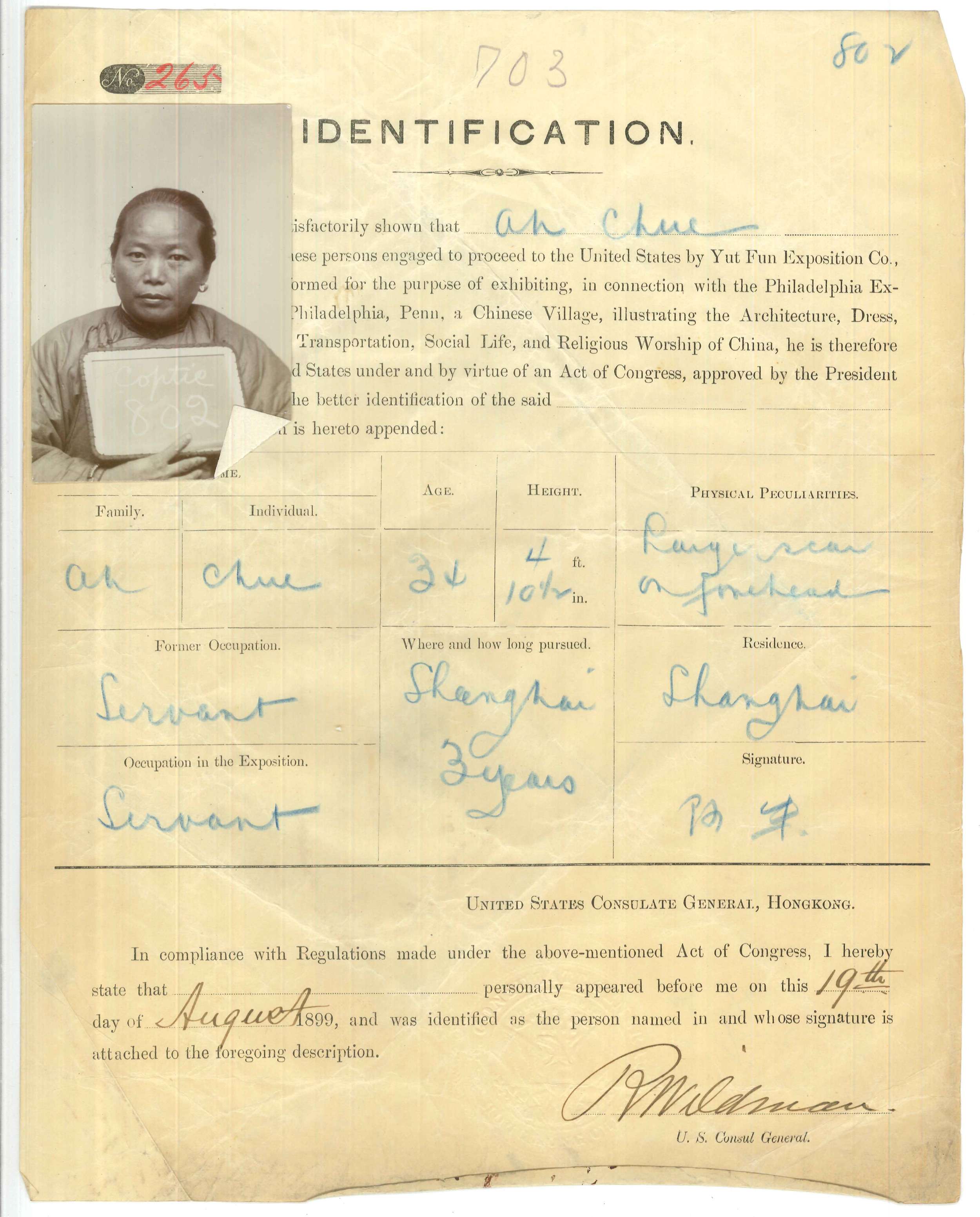
Document
Identification Paper of Louis Wai
8/19/1899
Louis Wai was a 26-year-old painter who appeared at the "Chinese Village" exhibition at the National Export Exposition in 1899 in Philadelphia, Pennsylvania. The purpose of the "Chinese Village" was to exhibit and illustrate the architecture, dress, industries, amusements, transportation, social life, and religious worship of China for onlookers at the National Export Exposition.
"Living exhibits" like the "Chinese Village" were often part of exhibitions and fairs in the late 1800s and early 1900s in Europe and the United States. They displayed non-Western people as curiosities, helping to promote the idea of Western progress and superiority that was commonplace at the time.
Louis Wai, along with the other performers, was allowed to enter the United States under an Act of Congress approved by President William McKinley on March 1, 1899. Most other Chinese were excluded from entering the country as a result of the Chinese Exclusion Act of 1882, and its extention in the form of the Geary Act of 1892.
This I.D. paper includes Louis Wai's name, age, height, physical description, occupation, location and length of time engaged in occupation, place of residence, signature, and photograph.
"Living exhibits" like the "Chinese Village" were often part of exhibitions and fairs in the late 1800s and early 1900s in Europe and the United States. They displayed non-Western people as curiosities, helping to promote the idea of Western progress and superiority that was commonplace at the time.
Louis Wai, along with the other performers, was allowed to enter the United States under an Act of Congress approved by President William McKinley on March 1, 1899. Most other Chinese were excluded from entering the country as a result of the Chinese Exclusion Act of 1882, and its extention in the form of the Geary Act of 1892.
This I.D. paper includes Louis Wai's name, age, height, physical description, occupation, location and length of time engaged in occupation, place of residence, signature, and photograph.
This primary source comes from the Records of the Immigration and Naturalization Service.
National Archives Identifier: 183550378
Full Citation: Identification Paper of Louis Wai; 8/19/1899; Identification Paper No. 262; Identification Papers of Chinese Exhibitors Appearing at the National Export Exposition of 1899, 1899 - 1899; Records of the Immigration and Naturalization Service, ; National Archives at Philadelphia, Philadelphia, PA. [Online Version, https://www.docsteach.org/documents/document/identification-paper-louis-wai, April 25, 2024]Identification Paper of Louis Wai
Page 1
